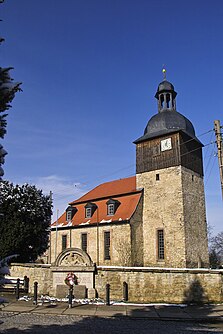Obernissa
|
Obernissa
Rural community of Grammetal
Coordinates: 50 ° 57 ′ 7 ″ N , 11 ° 8 ′ 53 ″ E
|
|
|---|---|
| Height : | 320 m above sea level NN |
| Incorporation : | March 14, 1974 |
| Incorporated into: | Mönchenholzhausen |
| Postal code : | 99428 |
| Area code : | 036203 |
|
Village church
|
|
Obernissa is a village southeast of Erfurt in the Weimarer Land district and a district of Grammetal .
geography
Obernissa lies on a flat saddle with the Grammetal in the north and the Osterbach valley in the south and west. The place is about 325 m above sea level with the highest point southeast of the village. Road connections lead in a westerly direction to Rohda , which already belongs to the urban area of Erfurt, and in the east to the motorway feeder A4- GVZ Erfurt. Obernissa is connected to the town of Büßleben by a road .
history
The area has been colonized from around 4000 BC. Proven by representatives of the band ceramic culture . The first recorded owner of the area was Count Heinrich von Gleichen , who pledged it to the city of Erfurt in 1296. The earliest known mention of Obernissa by name as Obern Nuweseze in a pledge deed by Count Hermann von Gleichen dates back to 1316. The name literally means "Ober-Neusitz" (or - "New settlement") and was used until the end of the 18th century numerous intermediate stages to "Obernissa" sanded. From 1296 to 1815 Obernissa belonged to the land area of the city of Erfurt . In 1802 the place came with this to Prussia and between 1807 and 1813 to the French Principality of Erfurt . With the Vienna Congress in 1815, Obernissa came to the Grand Duchy of Saxony-Weimar-Eisenach with the Tonndorf office , to whose Weimar administrative district it belonged from 1850.
The Waidanbau was from the Middle Ages to the 17th century an important economic factor. The trade in the dye obtained from the woad was an important source of income for the city of Erfurt and the surrounding agriculture. One of the millstones used in Obernissa went into the holdings of the Erfurt Folklore Museum in 1970 , but was returned in 1996 and put back in the village.
Attractions
church
The age of the village church Simon Petrus has not been passed down. After being damaged by a lightning strike, it was rebuilt in the Baroque style in 1721; the lower part of the tower is older. The pulpit altar dates from 1724, the altar Bible from 1797. The bell was donated in 1802 by a local resident.
→ See Simon Petrus (Obernissa)
Post mill
The post mill is located on the connecting path between Obernissa and Mönchenholzhausen and belongs to Obernissa by post. It was built in 1824 and the site is used as a riding stables today.
Ice Age boulder
According to studies by the former homeland researcher and honorary citizen Johannes Richter, the southernmost foothills of the so-called Elster Cold Age reached as far as Obernissa. This is where the flint line runs, up to which the ice deposited its mineral load.
Personalities
- Hilde Purwin (1919–2010), journalist
literature
- L. Richter, C. Lindner: Materials for the 700th anniversary of Mönchenholzhausen . 1996.
